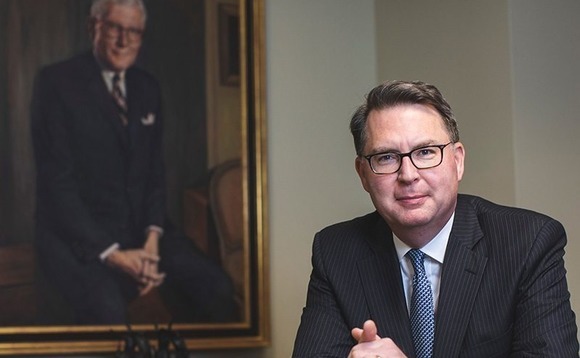
LP interview: Dietrich Foundation

The Dietrich Foundation, which has one of the highest China PE and VC allocations of any US LP, is cautious on the market but not disengaged. Meanwhile, India and Southeast Asia are becoming more interesting
The Pittsburgh-based Dietrich Foundation is among the minority of US institutional investors still open to making commitments to China funds. Representatives will return to the country later this year with a view to sitting down with various stakeholders, including existing GPs, and assessing the lay of the land.
"We often refer to Bill Dietrich's mantra, ‘You can't shoot moose from the lodge.' By that, he meant that if you just sit around reading The Wall Street Journal it doesn't make you insightful," said Edward J. Grefenstette, the foundation's president and CIO, who describes the current approach to China as modestly pausing.
"You need to be in the field, collecting first-hand information, and reaching your own conclusions. For us to invest wisely then, we feel it's critical to have lots of honest, face-to-face meetings on the ground with GPs and other trusted market participants."
The Bill Dietrich reference is apt because the imprint of the foundation's founder, who died in 2011, is still visible in the philosophy and structure. Not least, on recruiting Grefenstette in 2010, Dietrich crafted governance documents to allow the incoming CIO to operate as a long-term thematic investor and told the trustees that he expected the tenure to be at least 20 years.
This gives Grefenstette low personal career risk and facilitates a somewhat unique perspective on China. He breaks down the US LP community into equal parts: one-third is saying a hard no to more China; another third is not liquidating positions but planning to pause at least through 2023 for further study; and another third, including the Dietrich Foundation, remains receptive to the idea of investing in the country.
"We continue to believe that the next China-like opportunity is most likely China, so we are trying to be patient. If we see strong evidence of policy pragmatism, if we see more consistency between Beijing's rhetoric – that recently has sounded more accommodating to foreign investors – and Beijing's action, then our confidence will return," Grefenstette said.
"It's just that private equity and venture capital fund investing is, of course, a 12 to 14-year commitment. The level of trust you need to have in a given ecosystem is necessarily high."
In this context, the current fundraising difficulties are more a function of the macroeconomic and geopolitical conditions than concerns about the quality of the manager and the investment thesis. Still, the bifurcation between the perceived top echelon and the rest is expected to continue widening, with the rest delaying their fund launches because they aren't confident of raising enough capital.
Building a network
The foundation originated from wealth from Dietrich's family lumber business, which he turned into the largest supplier of light metal framing to the US construction industry. He exited in 1996 and placed USD 170m into a charitable trust that would covert into a foundation on his death. The beneficiaries were identified early on, with Dietrich prioritising education and his home city of Pittsburgh.
Until 2010, he oversaw the trust personally, visiting and backing dozens of managers around the world and growing the assets to USD 500m. China was introduced to the portfolio in 2006, with commitments spread across a relatively wide pool of VC and growth managers and an emphasis on local teams.
The foundation was an early backer of IDG Capital and an investor in the debut fund raised by Qiming Venture Partners. It also followed individuals from these firms into new ventures, notably IDG's technology, media, and telecom (TMT) team, which spun out to form Gaorong Capital, and J.P. Gan, formerly a managing partner at Qiming and now founder of Ince Capital.
"I knew J.P. when he was young and dashing instead of older and dashing," said Grefenstette, although he adds that spinouts – not Ince specifically – can be tricky. The departing individual's best deals are often claimed by others at the prior firm and poor investments might be assigned to them.
"While a team is intact, you need to build relationships and link investments to those who sourced them. If there's a spinout, you almost have a pre-populated attribution analysis."
The Ince spinout also underscores that preference for first-hand information. A call from Grefenstette, when Gan announced he would leave Qiming, was followed by dinner in Shanghai. "It gave me the chance to look a longtime friend in the eye and talk about his remaining goals and motivations," Grefenstette told AVCJ in 2019. "That was important for building the high conviction to move forward."
It doesn't end there. Grefenstette has previously described annual general meetings as informal intelligence-gathering exercises on GPs. For example, he likes to sit next to portfolio company CEOs at the opening dinner and ask questions like, ‘If an emergency comes up and you can call one person on your board, who do you call?' If there are four GPs invested in a company, the answer says a lot.
Travelling to China in the autumn, he will probe issues that GPs are reluctant to discuss on Zoom. These include how regulation is impacting the status of US dollar-denominated funds in China, especially the ability to deploy in sensitive sectors like semiconductors, and what this means for renminbi fundraising. Deal allocation has always been a concern when backing managers that operate in both currencies.
"There appears to be a tilt towards renminbi capital because Chinese founders are concerned about the future of US-China relations and where they might list. There was a period when renminbi funds were proliferating, and US dollar investors worried that misalignment would spoil the party. But, over the past decade, there was increasing comfort that USD capital was not materially disadvantaged," said Grefenstette.
"Unfortunately, this concern has once again surfaced. There appears to be a growing preference – especially in sectors strategically important to domestic innovation and supply chain security – for support from renminbi capital."
He has noted a pivot towards investment themes regarded as aligned to government policy – in part, a byproduct of the unforeseen crackdown on after-school tuition platforms in 2021 – and most readily manifested in surging interest in electric vehicles and cleantech. The foundation has received many white papers on how policies are impacting sector assessments; it will draw its own conclusions on the ground.
Deployment patterns
That willingness to travel – speaking during the pandemic, Grefenstette was adamant that he would resume his normal schedule as soon as possible – has underpinned commitments to 32 China managers to date. However, only six or seven are considered core relationships. The most recent re-up was earlier this year and the most recent new relationship was added in 2020.
The foundation now has USD 1.5bn in assets under management (AUM), of which 90% is deployed in private equity. Asia is 45% across all asset classes and China alone is currently 26% – down from a peak of 35% in 2020 due to distributions, markdowns, and fewer new commitments. Individual fund commitments are up to 1% of AUM for buyout and 50 basis points of AUM for venture.
"There are some LPs that try to ‘conviction weight' their commitments, saying, ‘Because I really like this manager, I will commit 2x what I normally do.' In fact, the data seems to suggest that LPs are rarely good at conviction weighting. We lean more towards the approach of either, ‘hell, yes!' or ‘hell, no!' We try to avoid committing a small amount to a GP just to see what happens," Grefenstette explained.
The foundation entered India in 2005 but was disappointed. The problem was that early enthusiasm around consumer didn't get support in the Series B and C rounds and companies flamed out. Expectations that India could follow China and deliver Alibaba Group and JD.com equivalents were thwarted by practical challenges such as poor infrastructure hampering the ability to scale.
It re-engaged six years ago, having noted an improvement in the quality of founders and a need for expansion of digital commerce infrastructure, which suggested opportunities for financial technology. There are now about 12 GP relationships, four of them core. As a mark of India's rise and China's moderation, each country accounts for about 15% of unfunded commitments.
"We believe the broader India VC ecosystem has reached an inflection point in the last few years – supported by expanding multinational investments," said Grefenstette. "The signals are strong: just look at Apple declaring that India will be home to 25% of global iPhone production by 2025. India is becoming a more predictable market and a place for quality, lower-risk growth."
Southeast Asia started to come under serious consideration in 2017 and there are three core relationships in the region. This does not include Chinese GPs decamping to Singapore and targeting Southeast Asia. The foundation is sceptical of this phenomenon, questioning whether GPs have the skills to deploy in these geographies and whether Indonesia can absorb all the capital being earmarked for it.
Grefenstette is not convinced that backing Chinese founders outside of China has merit, noting that local conditions vary and there are already talented entrepreneurs in Southeast Asia. It is still difficult to underwrite GPs given few in the market have meaningful track records. The foundation relies heavily on interviews with managers and background checks.
"Even when a manager has a limited track record, we will consider an investment if there is substantial evidence that the fund's leader would rather chew off his own arm than fail. That's a starting point," Grefenstette said. "Then you explore the team's competitive advantages, the team dynamics, and whether they are embracing best practices to execute as if it were a Fund III, not a Fund I."
The growing popularity of India and Southeast Asia, combined with the rapid growth that drives most investment theses, has led to significant increases in fund size as certain managers move through the vintages. The foundation asks about the calculation process, looking to establish if a target is anchored by ambition rather than reality, and what the optimum size would be to maximise net returns for LPs.
"One would think GPs would be well prepared for that question. Occasionally, the GP will admit that the fund's target is, in fact, the optimal fund size, while in the next breath explaining that the fund's hard cap might be 15%-20% larger than the target," said Grefenstette.
"Naturally, we then ask: ‘Why are you accepting capital over your optimal level except to achieve your own financial objectives on the fee side, at the sacrifice of the LPs?' When we see evidence that a GP is trying to raise what they can – instead of raising what they should – that is a serious red flag for us."
Latest News
Asian GPs slow implementation of ESG policies - survey
Asia-based private equity firms are assigning more dedicated resources to environment, social, and governance (ESG) programmes, but policy changes have slowed in the past 12 months, in part due to concerns raised internally and by LPs, according to a...
Singapore fintech start-up LXA gets $10m seed round
New Enterprise Associates (NEA) has led a USD 10m seed round for Singapore’s LXA, a financial technology start-up launched by a former Asia senior executive at The Blackstone Group.
India's InCred announces $60m round, claims unicorn status
Indian non-bank lender InCred Financial Services said it has received INR 5bn (USD 60m) at a valuation of at least USD 1bn from unnamed investors including “a global private equity fund.”
Insight leads $50m round for Australia's Roller
Insight Partners has led a USD 50m round for Australia’s Roller, a venue management software provider specializing in family fun parks.








